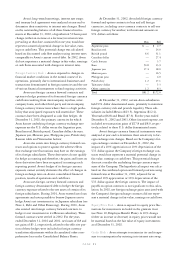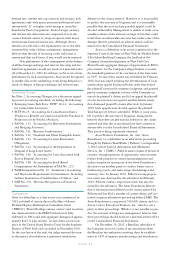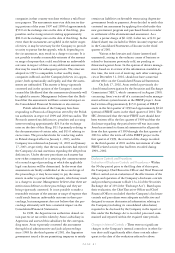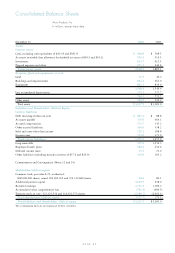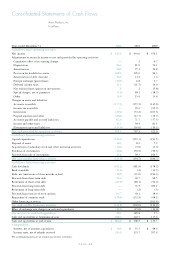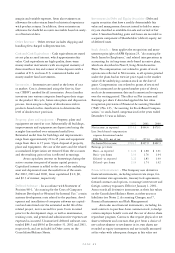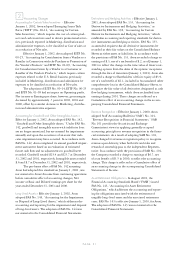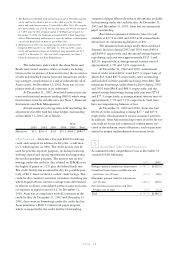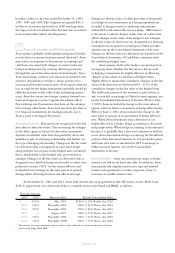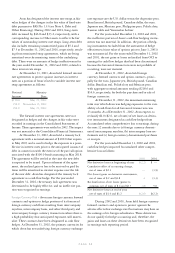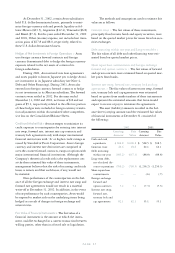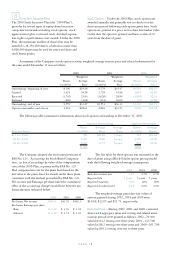Avon 2001 Annual Report Download - page 24
Download and view the complete annual report
Please find page 24 of the 2001 Avon annual report below. You can navigate through the pages in the report by either clicking on the pages listed below, or by using the keyword search tool below to find specific information within the annual report.
PAGE 48
Notes to Consolidated Financial Statements
Avon Products, Inc.
In millions, except per share data
Description of the Business and Summary
of Significant Accounting Policies
Business > Avon Products, Inc. (“Avon” or the “Company”)
is a global manufacturer and marketer of beauty and
related products. Avon’s business is primarily comprised of
one industry segment, direct selling, which is conducted
in North America, Latin America, the Pacific and Europe.
The Company’s reportable segments are based on geo-
graphic operations. Sales are made to the ultimate cus-
tomers principally by independent Avon Representatives.
The product categories include Beauty, which consists of
cosmetics, fragrance and toiletries (“CFT”); Beauty Plus,
which consists of jewelry, watches and apparel and acces-
sories; Beyond Beauty, which consists of home products,
gift and decorative and candles; and Health and Wellness,
which consists of vitamins, an aromatherapy line, exercise
equipment, as well as stress relief and weight manage-
ment products.
Avon launched a retail brand in the U.S. in the third
quarter of 2001. In January 2003, Avon announced that it
would end its business relationship with J.C. Penney and
sell the brand “beComing” through Avon’s direct selling
channel in the U.S. (see Note 17, Subsequent Events).
Significant Accounting Policies >
Principles of Consolidation > The consolidated financial
statements include the accounts of Avon and its majority
and wholly-owned subsidiaries. Intercompany balances
and transactions are eliminated.
Use of Estimates > These statements have been prepared
in conformity with generally accepted accounting princi-
ples in the U.S. and require management to make esti-
mates and assumptions that affect the reported amounts
of assets and liabilities, the disclosure of contingent assets
and liabilities at the date of the financial statements and
the reported amounts of revenues and expenses during
the reporting period. Actual results could differ materially
from those estimates. On an ongoing basis, management
reviews its estimates, including those related to allowances
for doubtful accounts receivable, allowances for sales
returns, provisions for inventory obsolescence, income
taxes and tax valuation, stock-based compensation, loss
contingencies and the determination of discount and other
actuarial assumptions for pension, post-retirement and
post-employment benefit expenses. Changes in facts and
circumstances may result in revised estimates, which are
recorded in the period in which they become known.
1Foreign Currency > Statement of Financial Accounting
Standards (“FAS”) No. 52 distinguishes between transla-
tion adjustments, which are usually reported as a separate
component of Shareholders’ (deficit) equity, and foreign
currency transactions, which are included in the determi-
nation of net income. Financial statements of foreign sub-
sidiaries operating in other than highly inflationary
economies are translated at year-end exchange rates for
assets and liabilities and average exchange rates during the
year for income and expense accounts. The resulting trans-
lation adjustments are recorded within Accumulated other
comprehensive loss. Financial statements of subsidiaries
operating in highly inflationary economies are translated
using a combination of current and historical exchange
rates and any translation adjustments are included in earn-
ings. Gains or losses resulting from foreign currency trans-
actions are recorded in earnings in Other (income)
expense, net.
Financial statement translation of subsidiaries oper-
ating in highly inflationary economies and foreign cur-
rency transactions resulted in net gains in 2002 ($16.0)
and net losses in 2001 ($7.7) and 2000 ($12.6), which are
included in Other (income) expense, net. Other (income)
expense in 2002 included transaction gains of $27.8
pretax related to U.S. dollar denominated assets, mainly
in Argentina, Venezuela, Brazil and Mexico. Foreign
exchange in 2001 included transaction gains of $8.0 pre-
tax related to the translation of a U.S. dollar intercompany
loan receivable on Avon Argentina’s balance sheet. In
addition, Cost of sales and Marketing, distribution and
administrative expenses included the unfavorable impact
of the translation of inventories and prepaid expenses at
historical rates in countries with highly inflationary
economies in 2002–$.7 (2001–$2.0; 2000 of $3.2).
Revenue Recognition > Net sales primarily includes sales
generated as a result of Representative orders less any dis-
counts, commissions, taxes and other deductions. Avon
recognizes revenue upon delivery, when both title and
risks and rewards of ownership pass to the independent
Representatives, who are Avon’s customers. Avon’s inter-
nal financial systems accumulate revenues as orders are
shipped to the representative. Since Avon reports revenue
upon delivery, revenues per the financial system must be
reduced for an estimate of the financial impact of those
orders shipped but not delivered at the end of each report-
ing period. Avon uses estimates in determining revenue
and operating profit for orders that have been shipped but
not delivered as of the end of the period. These estimates
are based on daily sales levels, delivery lead times, gross



